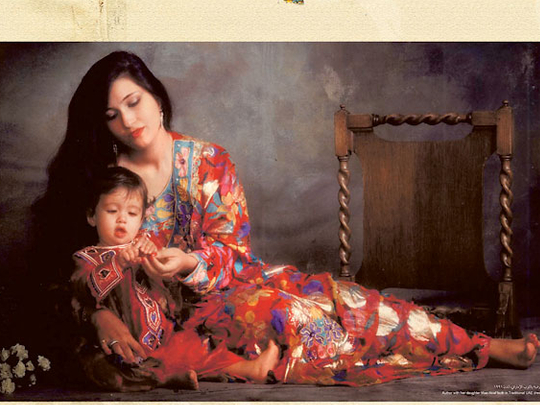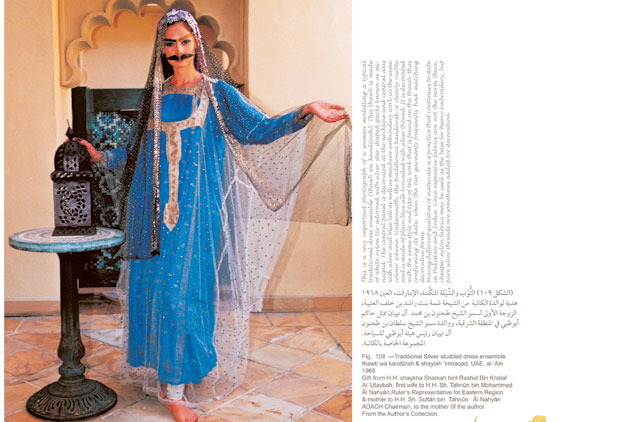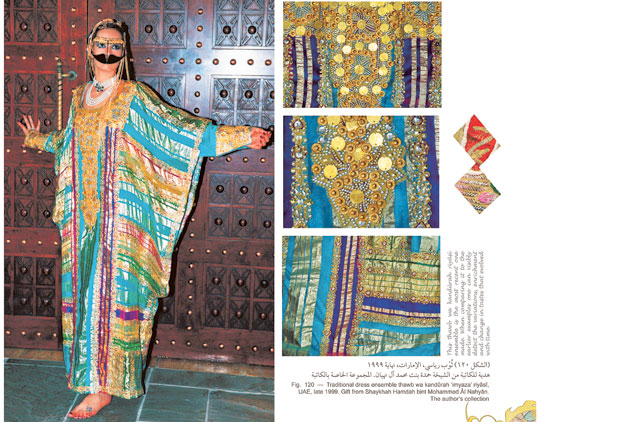
Dubai: In her book, author Dr Reem Al Mutwalli has recorded the continuous changes in traditional clothing styles mirroring the economic and social transformations, which took place in the United Arab Emirates in years past.
The book, Sultani, Traditions Renewed: Changes in Women’s Traditional Dress In the UAE during the reign of the late Shaikh Zayed Bin Sultan Al Nahyan, (1966-2004), is a sweeping look back through decades of transformation and tradition.
Al Mutwalli places local clothing in its historical, cultural, social, economic and ethnographic contexts, tracing the impact during the last 40 years of oil wealth, urbanisation, access to international markets and the pressures of globalisation on a relatively conservative Islamic Arab society.
She also discusses the forms of dress worn by UAE women from the 1960s to 2004, linking them with the rapid social and economic changes that took place during that period.
Asked by Gulf News about how women maintained traditional dress, preserving its significance and notions of Islamic versus non-Islamic dress, Al Mutwalli said that “dress has been important in preserving the status of indigenous women in the UAE, in the face of the overwhelming influx of an expatriate community”.
She also pointed out that throughout her book, “aspects of traditional clothing are examined in relation to social status, competitive displays of honour, wealth and identity, convention, good manners, piety, and spiritual conviction.”
Regional influences
She added that she traced the regional and other influences on design, and examines the details of materials, decorative trimmings and motifs, terminology and techniques.
“I also discuss how the huge and rapid increase in wealth affected the development of dress manufacture, trade in textiles, and tailoring workshops. I examine certain lifestyles and customs, and see their connection with dress forms that have been rapidly disappearing. I study how culture, religion, identity, conformity and the changing role of women are evidenced through the dress worn by women in the UAE in this period, and put the present state of UAE women’s dress in the context of the broader Arab Islamic world.”
Although she was born in Iraq, she has lived in the UAE since the age of five when her father was appointed economic consultant to the then crown prince Shaikh Khalifa Bin Zayed Bin Sultan Al Nahyan.
Because of this, she was fortunate to have almost exclusive personal access to the ruling family and elite members of UAE society. This, together with the in-depth individual interviews and group discussions that she conducted enabled her to collect first-hand accounts from people who have lived through the social changes described.
These exclusive first-hand accounts formed the keystone to her study, in contrast to studies that use interpretations of archaeological finds or the analysis and views of those who have not had direct access to women in the UAE.
Al Mutwalli said she was privileged to examine beautiful examples of carefully preserved clothing, many of which came from the private collections of members of the ruling family.
Interest in providing help was so high that an older form of dress presently extinct, the gold-studded mask (burghu), was commissioned by Shaikha Hamda Bint Mohammad Al Nahyan for the benefit of this study.
Shaikha Hamda was also the first to grant permission to photograph her own gold-studded dress (thawb), that once might have accompanied such a face cover, and graciously presented Reem with a replica of it, opening the door for others to follow suit and allow her to photograph their dresses.
More recent examples and contemporary interpretations of traditional dress came from the private collections of Shaikha Ushah Bint Shakbout Al Nahyan and Shaikha Salama Bint Hamdan Al Nahyan.
Still other examples belonged to members of prominent families, such as the large abaya collection belonging to Asmae’ Sidiq Al Mutawae.
Al Mutwalli told Gulf News that, with the help of Abdul Illah Al Khunji, a comprehensive collection of traditional textiles used in the costumes of UAE women was sourced, catalogued, and photographed.
“It is almost impossible to find any traces of textiles in the UAE or remnants of costumes that date back more than 60 years or so. For the most part, fabrics are very fragile and they quickly deteriorate in the inhospitable climatic conditions characteristic of the area under study,” she added.
None of the local museums have any examples of such artefacts among their displays or within their collections. Costumes shown there are modern reconstructions of what used to be available. She also pointed out that the relative poverty of the pre-oil era forced the economical use of clothes and their constant recycling. Clothes were mostly worn to a point of disintegration, or handed to needy others.
Al Mutwalli concludes that “unspoiled segments were reused in making newer garments. Ironically, in the post-oil years costumes are still not being conserved. The abundance of materials and costumes being made for today’s consumers encourages the continuous discarding of garments in favour of fashions that change by the season or even weekly.
“It is a pity that these modern costumes are not being preserved since many of them are elaborately embellished, intricately designed, mostly handmade, and costly. Many of them warrant some sort of conservation as works of art.”













